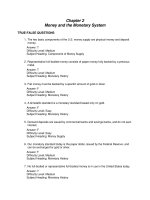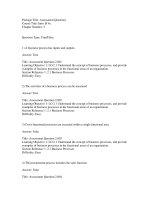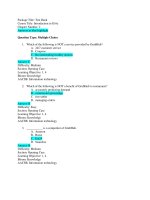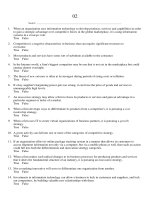Introduction to information systems supporting and transforming business 6th edition by rainer prince test bank
Bạn đang xem bản rút gọn của tài liệu. Xem và tải ngay bản đầy đủ của tài liệu tại đây (291 KB, 20 trang )
Introduction to Information Systems: Supporting and Transforming Business
6th edition by R. Kelly Rainer, Brad Prince Test Bank
Link full download test bank: />Link full download solution manual: />Chapter Number: 2
Answers in blue highlight
Question Type: Multiple Choice
1. Which of the following is NOT a service provided by GrubHub?
A. 24/7 customer service
B. Coupons
C. Recommending healthy options
D. Restaurant reviews
Answer: C
Difficulty: Medium
Section: Opening Case
Learning Objective: 1, 4
Bloom: Knowledge
AACSB: Information technology
2. Which of the following is NOT a benefit of GrubHub to restaurants?
A. accurately predicting demand
B. commission percentage
C. free tablet
D. managing orders
Answer: B
Difficulty: Easy
Section: Opening Case
Learning Objective: 1, 4
Bloom: Knowledge
AACSB: Information technology
3. ___________ is a competitor of GrubHub.
A. Amazon
B. Boost
C. Eat24
D. Seamless
Answer: B
Difficulty: Medium
Section: Opening Case
Learning Objective: 1, 4
Bloom: Knowledge
AACSB: Information technology
4. A competitive advantage refers to any ___________ that provide an organization with an
edge against its ___________ in some measure such as cost, quality, or speed.
A. assets; competitors
B. assets; customers
C. costs; competitors
D. costs; customers
Answer: A
Difficulty: Easy
Section: Introduction
Learning Objective: 4
Bloom: Knowledge
AACSB: Information technology
5. __________ information system can be strategic ___________.
A. Any; because technology always provides an advantage
B. Any; if it is used properly
C. No; since everyone has access to technology
D. No; when it is customized
Answer: A
Difficulty: Easy
Section: Introduction
Learning Objective: 4
Bloom: Knowledge
AACSB: Information technology
6. Which of the following is NOT a fundamental element of a business process?
A. Feedback
B. Input
C. Output
D. Resources
Answer: A
Difficulty: Easy
Section: Business Processes
Learning Objective: 1
Bloom: Knowledge
AACSB: Information technology
7. ________ are materials, services, and information that flow through and are
transformed as a result of process activities.
A. Inputs
B. Outputs
C. Processes
D. Resources
Answer: A
Difficulty: Easy
Section: Business Processes
Learning Objective: 1
Bloom: Knowledge
AACSB: Information technology
8. An order from a customer is a(n) __________ for a business process.
A. Feedback
B. Input
C. Output
D. Resource
Answer: A
Difficulty: Medium
Section: Business Processes
Learning Objective: 1
Bloom: Comprehension, Application
AACSB: Information technology
9. When a customer receives a product, this is a(n) ___________ for a business process.
A. Feedback
B. Input
C. Output
D. Resource
Answer: C
Difficulty: Medium
Section: Business Processes
Learning Objective: 1
Bloom: Comprehension, Application
AACSB: Information technology
10. The manufacturing equipment a company purchases is a(n) __________ for a
business process.
A. Feedback
B. Input
C. Output
D. Resource
Answer: D
Difficulty: Medium
Section: Business Processes
Learning Objective: 1
Bloom: Comprehension, Application
AACSB: Information technology
11. Which of the following is an example of an efficiency metric?
A. Good work environment
B. Helpful customer service
C. High-quality products
D. Short customer wait-times
Answer: D
Difficulty: Hard
Section: Business Processes
Learning Objective: 1
Bloom: Knowledge
AACSB: Information technology
12. Procurement is NOT completed in this functional area:
A. Accounting
B. Purchasing
C. Sales
D. Warehouse
Answer: C
Difficulty: Easy
Section: Business Processes
Learning Objective: 1
Bloom: Knowledge
AACSB: Information technology
13. Fulfillment is triggered in the _________ department.
A. Accounting
B. Purchasing
C. Sales
D. Warehouse
Answer: C
Difficulty: Easy
Section: Business Processes
Learning Objective: 1
Bloom: Knowledge
AACSB: Information technology
14. Information systems do NOT play a vital role in __________.
A. capturing and storing process data
B. executing business processes
C. monitoring process performance
D. All of the above
Answer: D
Difficulty: Easy
Section: Business Processes
Learning Objective: 1
Bloom: Knowledge
AACSB: Information technology
15. RFID tags and bar codes are used in which process?
A. capturing and storing process data
B. executing a process
C. monitoring process performance
D. all of the above
Answer: A
Difficulty: Medium
Section: Business Processes
Learning Objective: 1
Bloom: Knowledge
AACSB: Information technology
16. Dashboards are used in which process?
A. capturing and storing process data
B. executing a process
C. monitoring process performance
D. all of the above
Answer: A
Difficulty: Hard
Section: Business Processes
Learning Objective: 1
Bloom: Knowledge, Application
AACSB: Information technology
17. NASCAR’s pre-race inspection is a ___________.
A. Business process
B. Reengineering tool
C. Response to societal pressure
D. Strategic advantage
Answer: A
Difficulty: Easy
Section: NASCAR Uses IT in Its Pre-Race Inspection
Learning Objective: 1
Bloom: Knowledge
AACSB: Information technology
18. Which of the following is TRUE of NASCAR’s pre-race inspection app?
A. It makes it easier for race car drivers to ensure their cars pass inspection the
first time.
B. It probably met with little resistance from people who were used to the
tedious paper forms.
C. Officials can annotate violations with digital notes and photographs.
D. The dashboard makes it easy to quickly enter violations into the system.
Answer: C
Difficulty: Medium
Section: NASCAR Uses IT in Its Pre-Race Inspection
Learning Objective: 1
Bloom: Knowledge
AACSB: Information technology
19. Which of the following is NOT a benefit of NASCAR’s pre-race inspection app?
A. It makes it easier for race car drivers to ensure their cars pass inspection the
first time.
B. NASCAR executives can identify trends and patterns to help maintain a
level playing field for all racers.
C. NASCAR officials can drill down on any vehicle to review details about any
pending issues.
D. The pre-race inspection process has been simplified.
Answer: A
Difficulty: Easy
Section: NASCAR Uses IT in Its Pre-Race Inspection
Learning Objective: 1
Bloom: Knowledge
AACSB: Information technology
20. ________ is the result of optimizing the design, development, and production processes.
A. Cost reduction
B. Differentiation
C. Productivity
D. Quality
Answer: D
Difficulty: Easy
Section: Business Process Reengineering, Business Process Improvement, and Business Process
Management
Learning Objective: 2
Bloom: Knowledge
AACSB: Information technology
21. __________ is the result of optimizing operations and supplier processes.
A. Cost reduction
B. Differentiation
C. Productivity
D. Quality
Answer: A
Difficulty: Easy
Section: Business Process Reengineering, Business Process Improvement, and Business Process
Management
Learning Objective: 2
Bloom: Knowledge
AACSB: Information technology
22. ________ is the result of optimizing the marketing and innovation processes.
A. Cost reduction
B. Differentiation
C. Productivity
D. Quality
Answer: B
Difficulty: Easy
Section: Business Process Reengineering, Business Process Improvement, and Business Process
Management
Learning Objective: 2
Bloom: Knowledge
AACSB: Information technology
23. __________ is a methodology for achieving incremental improvements in the
effectiveness and efficiency of a process.
A. BPI
B. BPM
C. BPR
D. BPS
Answer: A
Difficulty: Easy
Section: Business Process Reengineering, Business Process Improvement, and Business Process
Management
Learning Objective: 2
Bloom: Knowledge
AACSB: Information technology
24. _________ is the most difficult, radical, lengthy, and comprehensive strategy.
A. BPI
B. BPM
C. BPR
D. BPS
Answer: C
Difficulty: Easy
Section: Business Process Reengineering, Business Process Improvement, and Business Process
Management
Learning Objective: 2
Bloom: Knowledge
AACSB: Information technology
25. Six Sigma is a popular _________ methodology.
A. BPI
B. BPM
C. BPR
D. BPS
Answer: A
Difficulty: Easy
Section: Business Process Reengineering, Business Process Improvement, and Business Process
Management
Learning Objective: 2
Bloom: Knowledge
AACSB: Information technology
26. The _________ stage in BPI is characterized by establishing process metrics
and monitoring the improved processes.
A. Analysis
B. Control
C. Improve
D. Measure
Answer: B
Difficulty: Easy
Section: Business Process Reengineering, Business Process Improvement, and Business Process
Management
Learning Objective: 2
Bloom: Knowledge
AACSB: Information technology
27. Chevron employed ________ to provided detailed work instructions to its employees.
A. Lean Six Sigma
B. Nimbus
C. SAP
D. Six Sigma
Answer: B
Difficulty: Medium
Section: IT’s About Business: BPR, BPI, and BPM at Chevron
Learning Objective: 2
Bloom: Knowledge
AACSB: Information technology
28. Chevron initially utilized ___________ to improve their supply chain, followed by
employee-driven ________ initiatives, and then adopted a unified _____ approach
to standardize business processes.
A. BPI, BPM, BPR
B. BPM, BPI, BPR
C. BPR, BPI, BPM
D. BPS, BPR, BPM
Answer: C
Difficulty: Easy
Section: IT’s About Business: BPR, BPI, and BPM at Chevron
Learning Objective: 2
Bloom: Knowledge
AACSB: Information technology
29. Chevron has used _________, a methodology that combines statistical process analysis
with techniques to eliminate waste and improve process flow, since 2006.
A. Lean Six Sigma
B. Nimbus
C. SAP
D. Six Sigma
Answer: A
Difficulty: Medium
Section: IT’s About Business: BPR, BPI, and BPM at Chevron
Learning Objective: 2
Bloom: Knowledge
AACSB: Information technology
30. Which of the following is a type of societal/political/legal pressure?
A. Carbon management
B. Globalization
C. Innovation
D. Powerful customers
Answer: A
Difficulty: Easy
Section: Business Pressures, Organizational Responses, and Information Technology Support
Learning Objective: 3
Bloom: Knowledge
AACSB: Information technology
31. Sarbanes-Oxley is an example of ________
A. a government regulation
B. customer focus
C. an ethical issue
D. our social responsibility
Answer: A
Difficulty: Easy
Section: Business Pressures, Organizational Responses, and Information Technology Support
Learning Objective: 3
Bloom: Knowledge
AACSB: Information technology
32. Palantir is NOT primarily used for ____________.
A. detecting fraud
B. identifying patterns
C. pricing mortgages
D. privacy protection
Answer: D
Difficulty: Hard
Section: Business Pressures, Organizational Responses, and Information Technology Support
Learning Objective: 3
Bloom: Comprehension
AACSB: Information technology
33. BYOD stands for
A. Be Your Online Discussion
B. Be Your Own Deadline
C. Bring Your Online Decision
D. Bring Your Own Device
Answer: D
Difficulty: Easy
Section: Business Pressures, Organizational Responses, and Information Technology Support
Learning Objective: 3
Bloom: Knowledge
AACSB: Information technology
34. Which of the following is a problem with BYOD?
A. Cost
B. Productivity
C. Satisfaction
D. Security
Answer: D
Difficulty: Medium
Section: Business Pressures, Organizational Responses, and Information Technology Support
Learning Objective: 3
Bloom: Knowledge
AACSB: Information technology
35. Banks have a lot of competition locally in addition to competing with online banks. This
concept applies to ____________.
A. Bargaining power of buyers
B. Bargaining power of suppliers
C. Threat of entry of new competitors
D. Threat of substitute products or services
Answer: A
Difficulty: Hard
Section: Competitive Advantage and Strategic Information Systems
Learning Objective: 4
Bloom: Application
AACSB: Information technology
36. The web ____________ buyer power.
A. decreases
B. increases
C. has no impact on
D. has a mixed impact on
Answer: D
Difficulty: Medium
Section: Competitive Advantage and Strategic Information Systems
Learning Objective: 4
Bloom: Application
AACSB: Information technology
37. Which of the following is a support activity in Porter’s value chain model?
A. Customer service
B. Human resource management
C. Logistics
D. Operations
Answer: B
Difficulty: Medium
Section: Competitive Advantage and Strategic Information Systems
Learning Objective: 4
Bloom: Application
AACSB: Information technology
38. WalMart has a(n) ___________ strategy.
A. Cost leadership
B. Customer orientation
C. Differentiation
D. Innovation
Answer: A
Difficulty: Easy
Section: Competitive Advantage and Strategic Information Systems
Learning Objective: 4
Bloom: Knowledge
AACSB: Information technology
39. Which of the following is TRUE?
A. Alignment within a single organization is fairly easy.
B. Businesses can utilize enterprise architectures to foster alignment.
C. Most organizations are able to achieve alignment.
D. Most IT and business executives agree on their level of alignment.
Answer: B
Difficulty: Easy
Section: Competitive Advantage and Strategic Information Systems
Learning Objective: 4
Bloom: Knowledge
AACSB: Information technology
40. Which of the following is NOT a characteristic of alignment?
A. Organizations rotate business and IT professionals across departments and job
functions
B. Organizations create a vibrant and inclusive company culture
C. Organizations view their IT department employees as supremely important
D. Organizations provide overarching goals that are completely clear to each IT and
business employee
Answer: C
Difficulty: Easy
Section: Competitive Advantage and Strategic Information Systems
Learning Objective: 4
Bloom: Knowledge
AACSB: Information technology
41. The OLPC’s experiment with solar-powered tablets took place in _______.
A. Bangladesh
B. Ethiopia
C. Rural US communities
D. Uganda
Answer: B
Difficulty: Easy
Section: IT’s About Business: Solar-Powered Tablets in Ethiopia
Learning Objective: 3
Bloom: Knowledge
AACSB: Information technology
42. The OLPC’s experiment with solar-powered tablets in Ethiopia ________.
A. showed some promise of being successful
B. showed very little promise of being successful
C. was a major failure
D. was a major success
Answer: D
Difficulty: Easy
Section: IT’s About Business: Solar-Powered Tablets in Ethiopia
Learning Objective: 3
Bloom: Knowledge
AACSB: Information technology
43. The goal of OLPC’s experiment with solar-powered tablets in Ethiopia was to ____.
A. improve literacy in children
B. reduce the digital divide
C. see if under-developed countries could use technology
D. test alternatives to battery power
Answer: A
Difficulty: Easy
Section: IT’s About Business: Solar-Powered Tablets in Ethiopia
Learning Objective: 3
Bloom: Knowledge
AACSB: Information technology
44. The Weather Channel is a powerful and well-known brand that is ________ viewers.
A. gaining
B. losing
C. maintaining
D. training
Answer: B
Difficulty: Easy
Section: IT’s About Business: The Weather Channel
Learning Objective: 3
Bloom: Knowledge
AACSB: Information technology
45. Which of the following is NOT a reason The Weather Channel is losing customers?
A. Mobile devices are now the primary source of weather information.
B. People prefer highly accurate short-term weather predictions rather than semireliable five-day forecasts.
C. They don’t have a mobile app.
D. They show too many reality TV shows.
Answer: C
Difficulty: Medium
Section: IT’s About Business: The Weather Channel
Learning Objective: 3
Bloom: Knowledge
AACSB: Information technology
46. __________ is NOT one of The Weather Channel’s main competitors.
A. Dark Sky
B. Sky Motion
C. WeatherSphere
D. Wunderground
Answer: D
Difficulty: Easy
Section: IT’s About Business: The Weather Channel
Learning Objective: 3
Bloom: Knowledge
AACSB: Information technology
47. Startups like Dark Sky can predict to the minute when it is going to start raining
or snowing within the next hour because they ______________.
A. are magicians and psychics
B. hired superior weather forecasters with PhDs
C. integrate and analyze data to improve short-term forecasting
D. really understand the weather better than anybody else
Answer: C
Difficulty: Easy
Section: IT’s About Business: The Weather Channel
Learning Objective: 3
Bloom: Knowledge
AACSB: Information technology
48. IBM’s Watson _______________.
A. can process structured and unstructured content
B. can diagnose diseases and recommend treatment
C. won Jeopardy!
D. All of the above
Answer: D
Difficulty: Easy
Section: Closing Case
Learning Objective: 1
Bloom: Knowledge
AACSB: Information technology
49. IBM’s Watson _______________ Jeopardy!.
A. lost to Ken Jennings on
B. was able to access Wikipedia while on
C. won $1 million on
D. none of the above
Answer: C
Difficulty: Easy
Section: Closing Case
Learning Objective: 1
Bloom: Knowledge
AACSB: Information technology
50. IBM’s Watson is a(n) _______________.
A. Dashboard
B. ERP system
C. Expert system
D. FAIS
Answer: C
Difficulty: Hard
Section: Closing Case
Learning Objective: 1
Bloom: Application
AACSB: Information technology
51. IBM’s Watson is used in which of the following industries?
A. Agriculture
B. Energy
C. Healthcare
D. Retail
Answer: C
Difficulty: Easy
Section: Closing Case
Learning Objective: 1
Bloom: Knowledge
AACSB: Information technology
Question Type: True/False
1. Effectiveness focuses on doing the right things.
Answer: True
Difficulty: Medium
Section: Business Processes
Learning Objective: 1
Bloom: Knowledge
AACSB: Information technology
2. Organizations adopt BPI to sustain BPM over time.
Answer: False
Difficulty: Easy
Section: Business Process Reengineering, Business Process Improvement, and Business Process
Management
Learning Objective: 2
Bloom: Knowledge
AACSB: Information technology
3. Chevron’s strategy was to analyze its existing processes to identify specific areas to
improve.
Answer: False
Difficulty: Easy
Section: IT’s About Business: BPR, BPI, and BPM at Chevron
Learning Objective: 2
Bloom: Knowledge
AACSB: Information technology
4. In mass production, a company produces a large quantity of items that are customized to
individual customers.
Answer: False
Difficulty: Easy
Section: Business Pressures, Organizational Responses, and Information Technology Support
Learning Objective: 3
Bloom: Knowledge
AACSB: Information technology
5. The bargaining power of buyers is low when buyers have many choices and high
when buyers have few choices.
Answer: False
Difficulty: Easy
Section: Competitive Advantage and Strategic Information Systems
Learning Objective: 4
Bloom: Knowledge
AACSB: Information technology
6. Alignment often fails because business and IT managers have different objectives.
Answer: True
Difficulty: Easy
Section: Competitive Advantage and Strategic Information Systems
Learning Objective: 4
Bloom: Knowledge
AACSB: Information technology
7. “Organizations promote business and IT professionals within their departments so they
become the experts in their functional area” is NOT a characteristic of excellent
alignment.
Answer: True
Difficulty: Medium
Section: Competitive Advantage and Strategic Information Systems
Learning Objective: 4
Bloom: Knowledge
AACSB: Information technology
Question Type: Fill-in-the-Blank
1. ____________are the people and equipment that perform process activities.
Answer: Resources
Difficulty: Easy
Section: Business Processes
Learning Objective: 1
Bloom: Knowledge
AACSB: Information technology
2. Business process__________ is a management system that includes methods and tools
to support the design, analysis, implementation, management, and continuous
optimization of core business processes throughout the organization.
Answer: management
Difficulty: Easy
Section: Business Process Reengineering, Business Process Improvement, and Business Process
Management
Learning Objective: 2
Bloom: Knowledge
AACSB: Information technology
3. ___________ relationship management is an organization-wide effort toward maximizing
the customer experience.
Answer: Customer
Difficulty: Easy
Section: Business Pressures, Organizational Responses, and Information Technology Support
Learning Objective: 3
Bloom: Knowledge
AACSB: Information technology
4. Strategic information systems provide a ____________________ by helping an
organization implement its strategic goals and improve its performance and productivity.
Answer: competitive advantage
Difficulty: Easy
Section: Competitive Advantage and Strategic Information Systems
Learning Objective: 4
Bloom: Knowledge
AACSB: Information technology
5. Business-information technology alignment is the tight integration of the ____________
with the organization’s strategy, mission, and goals.
Answer: IT function
Difficulty: Easy
Section: Competitive Advantage and Strategic Information Systems
Learning Objective: 4
Bloom: Knowledge
AACSB: Information technology
Question Type: Essay
1. In what three areas do information systems play a vital role? For each area, where is the
information system involved? Describe a business example for each area.
Answer:
1) Executing the process
a. Embedded/intertwined; Process fails without system working
b. Example – if the system is down, the company can’t take orders
2) Capturing and storing process data
a. Sometimes happens inside the system but sometimes has to be entered into it
b. Example – analytics, decision-making systems
3) Monitoring process performance
a. Instance level (specific task) or process level (the whole process); evaluation
b. Example – making sure everything is running smoothly (dashboards)
Difficulty: Medium
Section: Business Processes
Learning Objective: 1
Bloom: Knowledge, Comprehension
AACSB: Written and oral communication, Information technology, Application of knowledge
2. In your own words (i.e. go beyond the book definitions), what is the difference between
BPI, BPM, and BPR? If you joined the upper management team of a local manufacturing
company, how could you potentially use BPI, BPM, and BPR?
Answer:
1) BPI = incremental improvements; BPM = maintaining BPI over time; BPR =
radical improvements
2) BPI = getting employees to recommend ways their department could do things better;
BPM = ensure business processes are continually aligned with the strategy (meeting
frequently with lower management); BPR = implementing a new ERP system
Difficulty: Easy (first question), Hard (second question)
Section: Business Process Reengineering, Business Process Improvement, and Business Process
Management
Learning Objective: 2
Bloom: Comprehension, Application
AACSB: Written and oral communication, Information technology, Application of knowledge
3. What are the three market pressures discussed in the book? List one positive and one
negative for businesses that result from these pressures.
Answer:
1) Globalization
a. Positive = more customers because businesses can be everywhere
b. Negative = having to deal with many different cultures/needs
2) Changing Nature of the Workforce
a. Positive = access to many more people who couldn’t work in the past
b. Negative = have to adjust environments to work with those people
3) Powerful Customers
a. Positive = getting a lot more feedback from customers
b. Negative = customers with bad experiences have a lot more power to influence
potential customers in a bad way
Difficulty: Medium
Section: Business Pressures, Organizational Responses, and Information Technology Support
Learning Objective: 3
Bloom: Knowledge, Evaluation
AACSB: Written and oral communication, Analytical thinking, Information
technology, Application of knowledge
4. List and describe Porter’s five forces and the ways the Web influences them. Evaluate a
SINGLE COMPANY with each force (include your logic for your evaluation).
Answer:
1) Threat of entry of new competitors = the threat that new competitors will enter your
market is high when entry is easy and low when there are significant barriers to entry;
web = increases because easy to create a website but decreases because first mover will
set the standard
2) Bargaining power of suppliers = supplier power is high when buyers have few choices
from whom to buy and low when buyers have many choices; web = increases because
integrating supply chain increases switching costs but decreases because it is easier to
shop around
3) Bargaining power of buyers = buyer power is high when buyers have many choices from
whom to buy and low when buyers have few choices; web = decreases because loyalty
programs increase switching costs but increases because it is easier to shop around
4) Threat of substitute products or services = the threat of substitutes is high when there are
many alternatives to an organization’s products or services; web = increases because
substitutes can be created rapidly where information-based industries have highest threat
but decreases if can create switching costs
5) Rivalry among existing firms in the industry = threat from rivalry is high when there is
intense competition among many firms in an industry; web = increases because of
transparency
NOTE: for the evaluation piece, students can argue high or low but their logic must be sound
as noted above
Difficulty: Medium
Section: Competitive Advantage and Strategic Information Systems
Learning Objective: 4
Bloom: Knowledge, Comprehension, Application
AACSB: Written and oral communication, Information technology, Application of knowledge
5. List, describe, and provide a real world example of the five different strategies
for competitive advantage.
Answer:
1) Cost leader – selling at the lowest price; Walmart
2) Differentiation – selling a different product; Porsche
3) Innovation – selling something new; Apple
4) Operational effectiveness – being more efficient; Walmart
5) Customer oriented – treating customers better; Zappos
Difficulty: Easy
Section: Competitive Advantage and Strategic Information Systems
Learning Objective: 4
Bloom: Knowledge, Comprehension, Application
AACSB: Written and oral communication, Information technology, Application of knowledge









